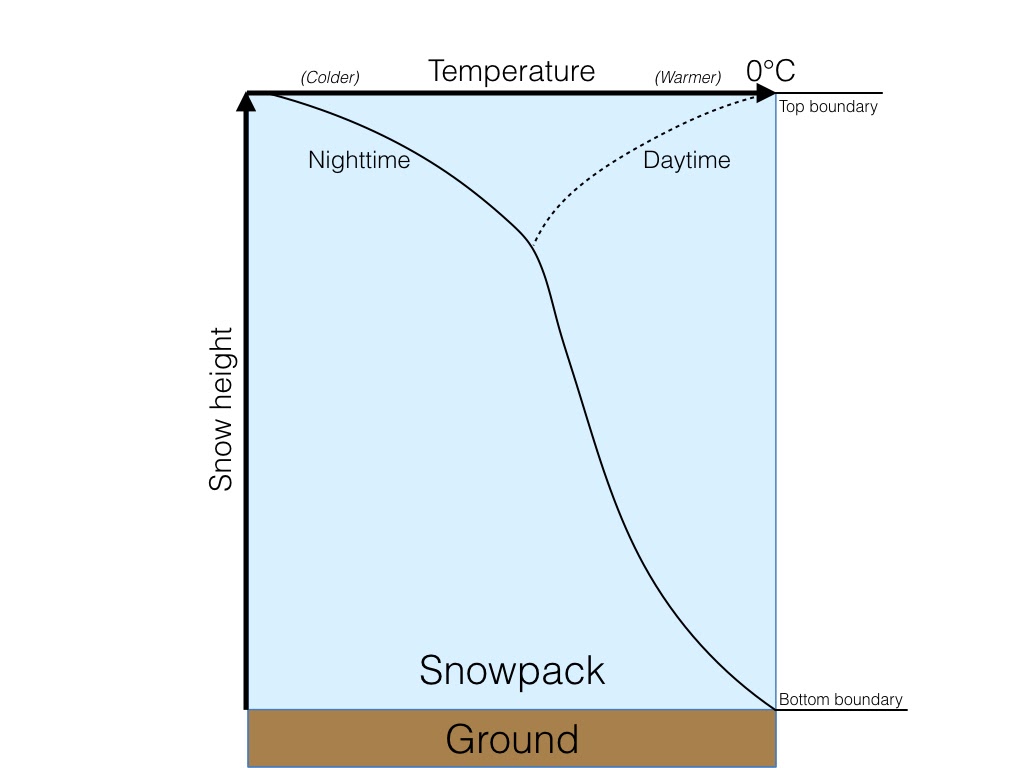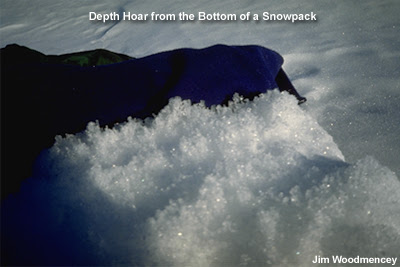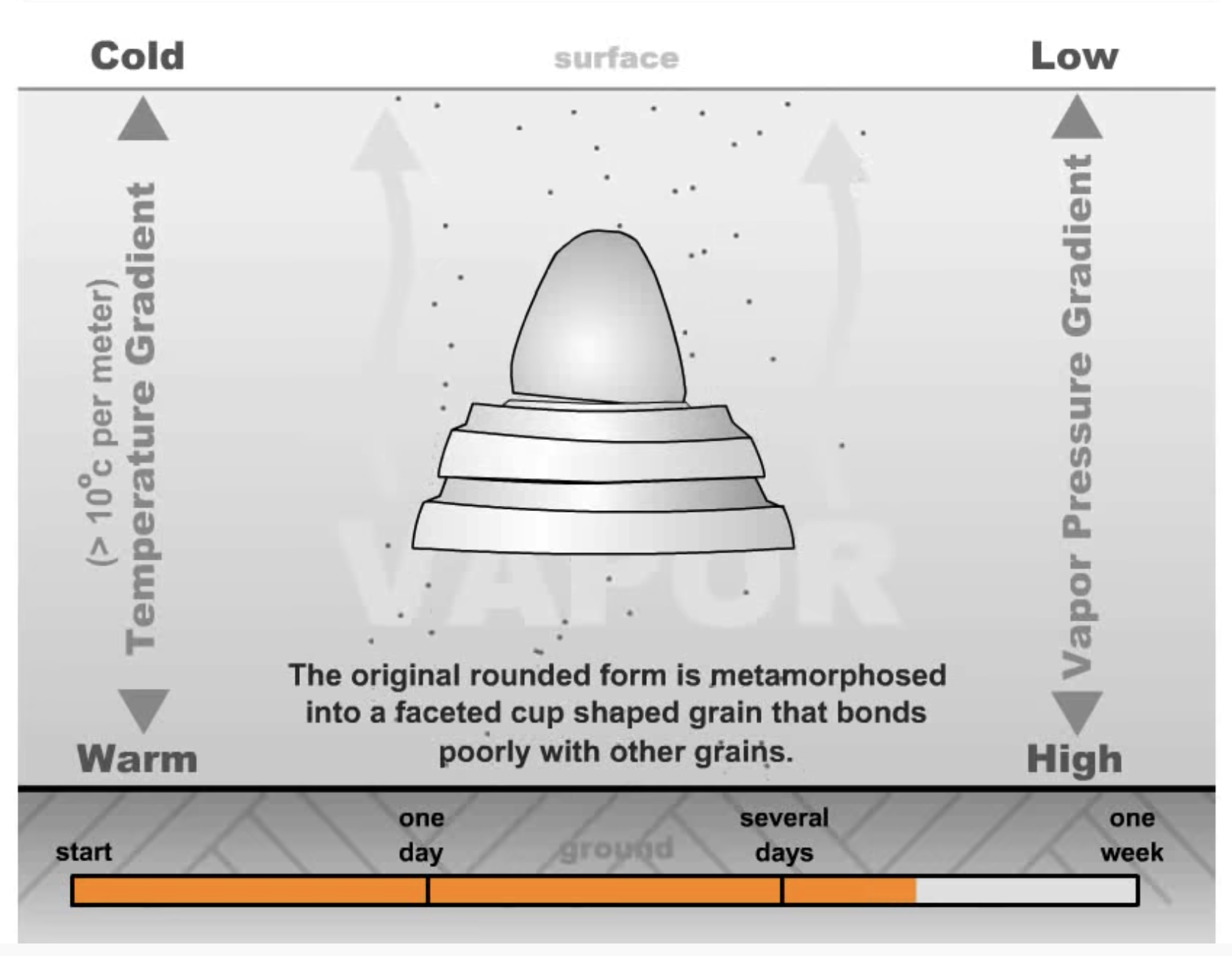ATSC 113 Weather for Sailing, Flying & Snow Sports
Snowpack Evolution
Learning Goal 7d. Explain the factors that influence snowpack
evolution.
Learning Goal 7e. List the conditions that are favourable for rounding
and faceting snow crystals.
Before we get into different crystal forms within the snowpack, and why they matter, it makes sense to introduce you to some information on snowpack evolution. Water exists in all three phases in the snowpack: ice (solid), water vapour (gas), and surprisingly, a small amount of liquid water. Liquid water content can be expressed as a percentage by volume. In cold, dry snowpacks, liquid water content is close to 0%.
The snowpack evolution processes described here are "dry", and only involve solid ice and water vapour. It is rare for liquid water content to exceed 8% in natural snowpacks. Essentially, you do not need to worry about "wet" processes involving liquid water either until spring time when the snowpack begins to melt, or during a warm storm e.g. at the coast.
Snowpack Evolution
The evolution of the snowpack, sometimes called snow metamorphism, is very complex. This section will highlight the important things to remember in terms of skiing and avalanches. When snow stops falling on top of a snowpack, the snowpack on the ground does not stop changing. There are still processes at work that continue to influence the snow crystal size and shape, snow density, snow depth, and how well the snow crystals are bonded together. All these factors can influence avalanche danger.
A gradient is a change in a property, such as temperature, over a distance (more on this later in Learning Goal 5h on warm fronts). There is a vertical temperature gradient in the snowpack because of the difference in temperature between where the snow meets the ground and where the snow meets the atmosphere (Fig. 7de.1).

Fig. 7de.1 - Typical snowpack temperature profiles for nighttime (solid black curve) and daytime (same as nighttime but top part is dashed). The blue area is the snow cover, while the brown region is the ground beneath the snowpack. The top boundary is where the snowpack and atmosphere meet, and the bottom boundary is where the snowpack and ground meet. Temperature increases to the right, with the maximum temperature being 0°C. (Credit: Howard.)
It may surprise you to know that the snow at the bottom of the snowpack (at bottom boundary with the ground) is usually at or very close to 0°C, due to some small amount of heating from the ground beneath. The top of the snowpack is influenced primarily by the atmosphere, which experiences a wide variety of temperatures and humidities. On average, the snowpack is colder at the top than at the bottom.
Snowpack temperature gradient is the most important factor that influences the evolution of the snowpack. Water vapour moves within the snowpack from warmer to colder temperatures. Further, the speed at which it moves is related to the temperature difference, i.e. how strong the temperature gradient is. Since the bottom of the snowpack is on average warmer than the top, water vapour within the snowpack generally travels upwards.
What is vapour pressure?
Remember that air pressure is a result of the weight of the air above you. Think of vapour pressure as the part of air pressure that is due to the weight of the water vapour in the air. In the snowpack, vapour pressure varies with temperature: the higher the temperature, the higher the vapour pressure, and vice versa. Just like air flows from regions of high air pressure to regions of low air pressure, water vapour will flow from areas of high vapour pressure to regions of low vapour pressure (Fig. 7de.2).
Thus, water vapour travels from warmer regions to colder regions, by sublimating from some crystals and depositing on others, changing the shape of those crystals. This explains why the temperature gradient in the snowpack is so important in terms of snowpack evolution.
Fig. 7de.2 - Animation showing water vapour sublimating then depositing from one snow crystal to another. (Credit: COMET/UCAR.)
Snow Crystal Forms
- There is a large temperature gradient, usually greater than 1°C change per 10 cm depth.
- A lot of space in between snow crystals.
- There is a small temperature gradient, usually less than 1°C change per 10 cm depth.
- Tightly packed crystals.
1. Faceted Crystals
Faceted crystals, or facets, are produced when a strong vertical temperature gradient exists. The water vapour is moving quickly, and crystal growth happens quickly. The rule of thumb is that faceting takes place when the temperature gradient is larger than 1°C per 10 cm depth, or equivalently 10°C per metre.
How does this strong vertical temperature gradient occur? Since the temperature near the bottom of the snowpack is relatively fixed near 0°C, we get a large temperature gradient when the snow surface is very cold. You don't need extremely cold air to get a very cold snow surface. As we discover in Learning Goal 7i (surface hoar), under clear, calm conditions at night, very strong temperature inversions can happen just above the snow surface. Thus, even on a night where the air temperature (typically measured 2 m above the surface) is -8°C, the snow surface could be around -18°C.
Another way that a strong temperature gradient occurs is when the same temperature difference occurs over a shorter distance. So, for the same temperature change between the top and bottom boundary, you will get a stronger temperature gradient in a shallower snowpacks (and a weaker temperature gradient in a deeper snowpack).
Thus, faceting occurs far more frequently in colder, continental climates, having drier, clearer weather, and shallower snowpacks. We discuss snowpack climates more in Learning Goal 7g.
A summary of rules for faceting:

Fig. 7de.3 Faceted snow crystals from deep down in the snowpack, also known as depth hoar. (Credit: COMET/UCAR.)
Under these conditions, snow crystals near the bottom of the snowpack (where it is warmer) can become very large and angular (Fig. 7de.3). This is also known as depth hoar.

Fig. 7de.4 - Faceting of a snow crystal as a
result of the conditions described above. See the animation
here .
2. Rounded Crystals
Rounded crystals, or rounds, are produced when temperature gradients are weak, water vapour moves slowly, and crystal growth happens slowly. Typical rounding occurs when the vertical temperature gradient within the snowpack is less than 1°C per 10 cm depth, or equivalently, 10°C per metre.
Why would the vertical snowpack temperature gradient be weak? Basically, imagine the opposite scenario than for faceting. Since the bottom of the snowpack is relatively fixed near 0°C, if the snow surface temperature is also near 0°C, the temperature gradient will be weak. Cloudy and/or windy nighttime conditions keep the snow surface warmer, and inhibit the formation of near-snow-surface temperature inversions in the air. That being said, cold snow-surface temperatures are still possible if a very cold air mass is in place.
Also, deeper snowpacks, where top-bottom temperature differences are more spread out, will have a weaker temperature gradient.
Thus, rounding occurs more often in warmer, wetter, coastal climates, where cloud cover is more frequent, and the snowpack is deeper (Learning Goal 7g).
A summary of rules for rounding:
Follow these links to see magnified photographs of: (1) rounded and faceted crystals, and (2) faceted and depth hoar crystals.
Here is a third photograph showing faceted (panel b) and
rounded (panel e) crystals
Why do we care about crystal metamorphism?
The characteristics of these little crystals have direct implications for avalanche danger. Generally speaking, faceted crystals are weakly bonded, making the snowpack weaker and more unstable. Rounded crystals are strongly bonded, making the snowpack stronger and more stable. You will learn more about this shortly.
Key words: snow metamorphism, gradient, snowpack
temperature gradient, faceted crystals, facets, depth hoar, rounded
crystals, rounds, rounding
Figure Credits: Stull: Roland Stull, West: Greg West, Howard: Rosie Howard
